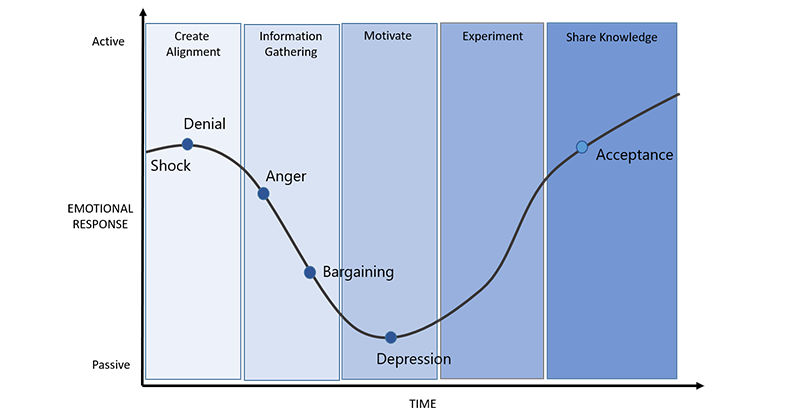 The Kubler-Ross grief cycle is one that we often witness within organisations when their IT implementation isn't supporting the business. Here is how it often manifests and some tips for how to manage the situation in order to reduce the pain.
The Kubler-Ross grief cycle is one that we often witness within organisations when their IT implementation isn't supporting the business. Here is how it often manifests and some tips for how to manage the situation in order to reduce the pain.
The first stage is always DENIAL. Leaders within the organisation feel that IT is adequately funded (there was that big capital investment 2 years ago and everything seems to be running okay now). There is no appetite to explore IT operations or seek service improvements as other aspects of the organisation are of higher importance. Requests for change are avoided as it simply isn’t a business priority. There may be fear from employees of rocking the boat and challenging this view. A sneaking suspicion prevents anyone from asking any probing questions that might result in a call for action. Here the savvy IT leader tries to create alignment between the business challenges and IT requirements to establish the key priorities for the organisation and the service levels required to support business as usual.
Inevitably ANGER is brewing. Systemic IT issues haven’t yet been tackled and there is organisational irritation and frustration that IT has become a stumbling block to success. IT issues have finally been recognised at board level but the IT team harbours anxiety that the crisis created by poor choices or under-investment and lack of business alignment is pinned on a lack of skills and knowledge. It is likely that there may have been a major outage that has caused concerns about business continuity. In worst cases there may have been customer services and public relations issues that reveal that the under resourced IT Services threatened the health of the organisation.
At this stage it is extremely important to build communication to gather information about all the issues and concerns your users may have to generate a true picture of what and where the pain points are for your organisation and conducting specialist audits for additional insight where required. This can become a turning point for users and teams who previously may have been highly critical of your IT service as they begin to feel that their concerns are being addressed and this process helps galvanise the organisation around a shared view what is really required.
If you haven’t begun to listen to the issues this can be the point that staff start to take things into their own hands. A manager with a pet project sneaks in some shadow IT because it’s a quick win strategically – yes that’s right the BARGAINING has begun. For the IT department it’s the thin end of the wedge. Sure, the pet project is up and running, but it doesn’t comply with IT standards and it doesn’t play well with the other internal systems. Furthermore, when it doesn’t work Paula is straight down to IT to complain and it has now become an overhead for the IT team.
It can be easy at this stage to say no to all new developments until the big picture has been finalised. A better approach may be to accept that business needs to keep moving and whilst there is no harm experimenting for example with a SaaS solutions for CRM, this has to be done in conjunction with the correct standards and have a place within a broader strategy that manages the risks for the organisation.
If you don’t subscribe to the view that controlled experimentation and collaboration is permitted, this may be the point at which the IT team begins to feel somewhat OVERWHELMED. Attempts to standardise are seen as needless bureaucracy. The firefight to maintain business as usual swamps the team and prevents any real service improvement or project delivery. At this point the true IT talent, bored at being unable to implement meaningful change begin to take flight. However, if you have started some controlled experiments or IT quick wins staff may feel motivated to proactively look for best fit solutions. By trialling new things you can build evidence on which to develop the business case further and develop internal capability.
By now it is ACCEPTED throughout the organisation that a more strategic approach needs to be taken to IT. Whilst IT isn’t an ends in itself, most of the organisations strategic aspirations require healthy IT service delivery and programme for development. Lack of IT funding is seen as risk to operations. At this point organisations seek external advice from expert advisors to help them tackle the foundational change required to build the infrastructure and systems needed. A strategic transformation plan is put in place. And the organisation breathes a sigh of relief and evolves. But this is not the time to cease communication, this is the point you share knowledge about the process you have been through in order to promote a collaborative culture in order to aid further transformation in the future.
The key to success however, is monitoring your projects and ensuring that the objectives are realised otherwise, like snakes and ladders, you can find yourself down a slippery slope right back to the beginning at DENIAL.
Fordway helps organisations at any stage of this cycle through the transformation needed to realise the benefits of IT investment. From high-level strategy, to detailed requirements we bring it all together implementing solutions that deliver and optimise for your business as usual.

